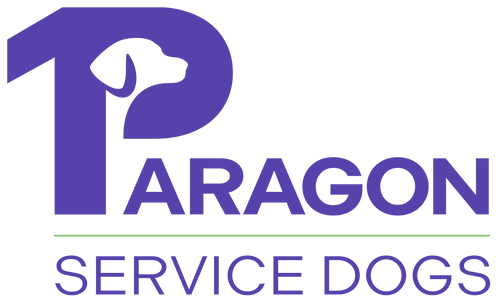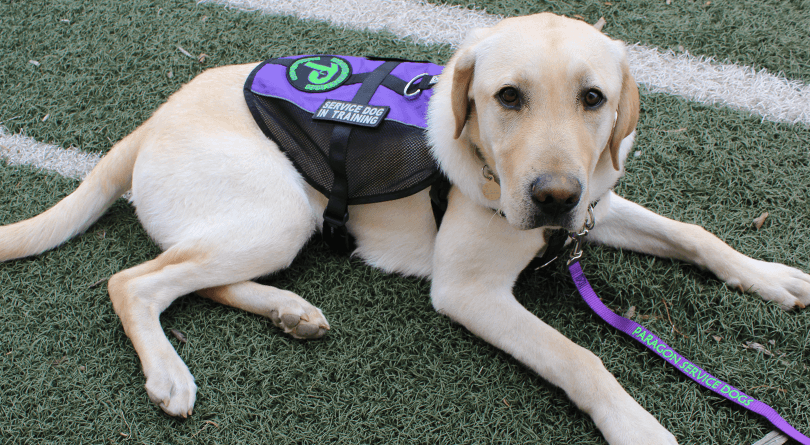got questions about hearing service dogs? we've got answers
When exploring the possibility of teaming up with an hearing dog, there are many things to consider, so we've gathered together some of the most common questions and answers to help you through the process. Got additional questions? Check out the ADA Resources section or contact us.
what is a hearing dog?
Assistance Dogs International defines a hearing dog as a dog that alerts individuals who are deaf or hard of hearing to specific sounds. The presence of a dog for protection, personal defense, or comfort does not qualify that dog as a hearing dog.
- Hearing Dogs assist deaf and hard of hearing individuals by alerting them to a variety of household sounds such as a door knock or doorbell, alarm clock, oven buzzer, telephone, baby crying, name call or smoke alarm.
- Hearing Dogs are trained to make physical contact and lead their d/Deaf and hard of hearing partners to the source of the sound.
- Hearing Dogs are generally Labrador Retrievers weighing 55-70 pounds.
- Hearing Dogs are identified by leash and/or vest.
how does a hearing dog serve at home?
Paragon hearing service dogs are trained to alert their partner to household sounds (doorbell, phone call, appliance buzzers, emergency alarms, etc.) fundamental to everyday safety and independence needs. Trained through shaping techniques, a hearing dog physically connects with and leads their person to the sound source. Hearing dogs provide increased freedom, confidence, interaction, and safety through their reliable alerting, physical presence, and companionship.
how does a hearing dog serve in public?
Hearing dogs serve as both an awareness meter as well as a connector when in public. The hearing dog handler can receive cues about the environment around them from paying attention to what their hearing dog is responding to. Paragon hearing dogs wear a vest, visually signaling the typically invisible disability of being d/Deaf or hard of hearing. This visibility can foster interactions in which most people make a concerted effort to communicate with patience and understanding. Further, hearing dogs build bridges between their handler and the people in the community, as a hearing dog provides a reason to interact and make new connections.
who qualifies for a paragon hearing dog?
Hearing dog candidates consist of adults who meet the minimum criteria for a hearing dog, regardless of race, religion, national origin, ethnicity, gender identity, disability, or sexual orientation. These criteria include:
- At least 18 years old and completing this application on my own or with minimal assistance (excluding interpreting needs)
- Live alone, with dependents, or with others who are d/Deaf (homes with other hearing adults may be considered on a case-by-case basis)
- Do not have another dog in the home (exceptions are typically granted for retired Paragon hearing dogs)
- Are able to complete an initial evaluation (1-2 days) and later team training (10-11 days) onsite at Paragon north of Denver at my own expense, and I will be able to work independently during these days (Paragon provides certified interpreters)
- Are able to walk a dog on a leash for 30 minutes daily, without an assistive device and without falling
- Can legally drive and/or have 20/40 vision in at least one eye (when corrected)
- Are financially, psychologically, cognitively, and physically able to provide a hearing dog's care, exercise, and ongoing training for 10 or more years
why does paragon not place in homes with another dog?
Paragon's policy is not to place a hearing dog in a home that already has one or more dogs, though Paragon may grant an exception for a retired hearing dog. Another dog in the house is a distraction to the hearing dog's work and partnership. The team needs to practice and train daily, especially in the first several months - it is a huge commitment. Bonding as a hearing dog team is crucial to the success and resiliency of the match. Even after the client and hearing dog have bonded and are working well together, no other dogs can be permanently in the home for the duration of the hearing dog's working career. Other pets such as cats are acceptable, and all hearing service dogs are desensitized to be comfortable with cats.
what does a hearing service dog do?
Hearing dogs are trained service dogs that alert people who are d/Deaf or hard of hearing to sounds around them. For example, they can alert to sounds of a door knock or doorbell, telephone, alarm clock, smoke alarm, and baby cry. Each hearing dog is custom trained to a client's needs and lifestyle. From microwave dings to garbage disposal sounds, the hearing dog's ability to grow in the job is remarkable.
what size and age are paragon hearing service dogs?
Hearing dogs come in all sizes, though mainly we select medium to large size candidates. As hearing dogs alert by touching, or nudging the person and then leading them to the source of the sound, they need to be a manageable size. Therefore, we do not generally select dogs over 70 pounds due to the execution of their alerting tasks.
can i pick what breed of hearing dog i receive?
Paragon trainers consider the best prospective matches for clients based on lifestyle, environment, and other vital factors. Clients can state limited preferences, such as size and activity level, which are considered when matching.
how much does training a hearing service dog cost paragon?
Hearing dogs are placed at no cost to clients. Paragon's cost to select, care for during training, train, match, and place one dog is $20,000. This expense is offset through the support of individuals, service clubs, foundations, sponsorships and fundraising events and campaigns.
how long does it take to receive a hearing service dog?
Wait times of 15-24 months will be typical, from the time an applicant is approved for a hearing dog to a match.
can i legally take my hearing dog with me everywhere i go?
Not everywhere, but most places thanks to the Americans with Disabilities Act (ADA) passed in 1990. The ADA guarantees a blind, d/Deaf, or physically disabled person the legal right to be accompanied by a service animal in all areas open to the general public.
Service animal means any guide dog, signal dog, or animal individually trained to do work or perform tasks for the benefit of an individual with a disability, including but not limited to:
- Guiding individuals with impaired vision
- Alerting individuals with impaired hearing to intruders or sounds
- Providing minimal protection or rescue work
- Pulling a wheelchair
- Fetching dropped items
*PLEASE NOTE, laws are state-specific regarding hearing dog accessibility in public, the home, and places of employment, as well as owner fees, licenses, and training requirements. Contact us to learn more about your state.
can my dog become a hearing dog?
It is possible. Paragon does have an owner trained program. You are your dog would need to complete an evaluation in order to qualify. For more information visit the Owner Trained Hearing Dog page.
can i still apply for a hearing dog if i live outside colorado?
Yes. Paragon Service Dogs is located in Colorado but matches hearing services dogs with persons who are d/Deaf or hard of hearing in all 50 states, Washington DC, and Canada.
what if i don’t qualify for a hearing dog but need the companionship of a good dog?
Due to the high volume of applicants and our waiting list, we do not train dogs outside of the primary skill set required of a hearing service dog. We recommend seeking a companion from your local shelters or rescue groups.

